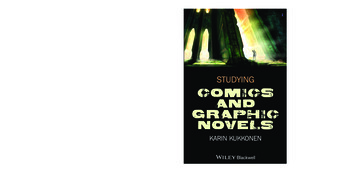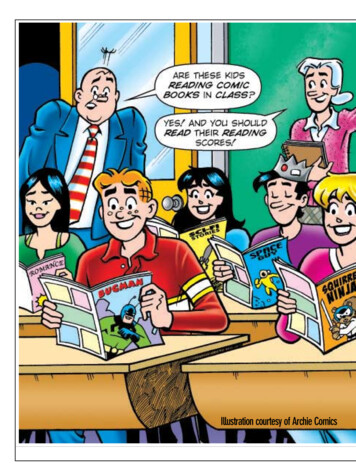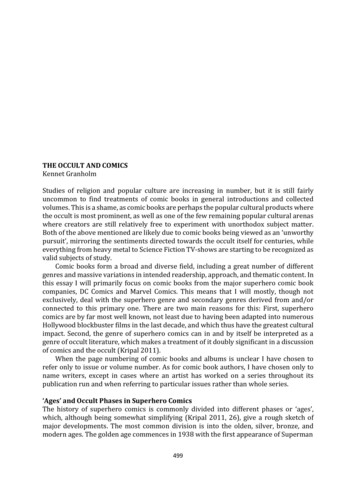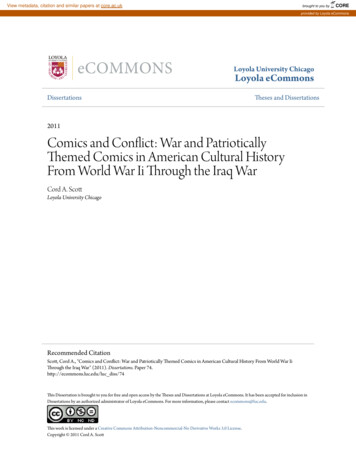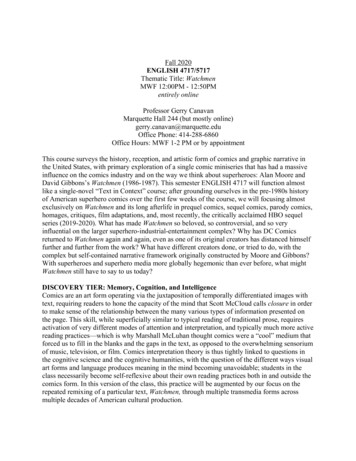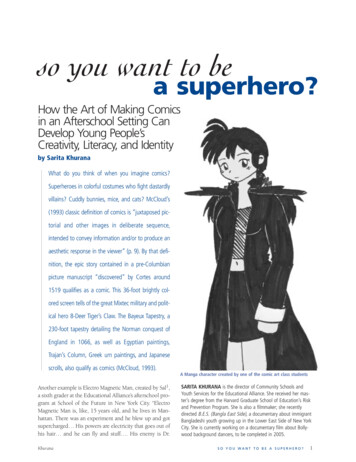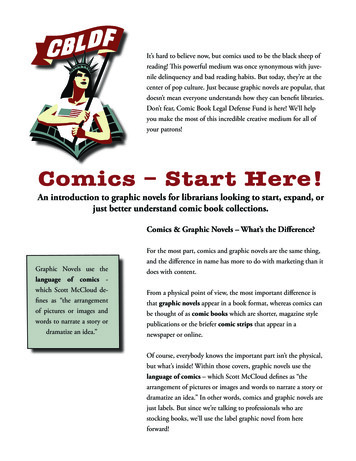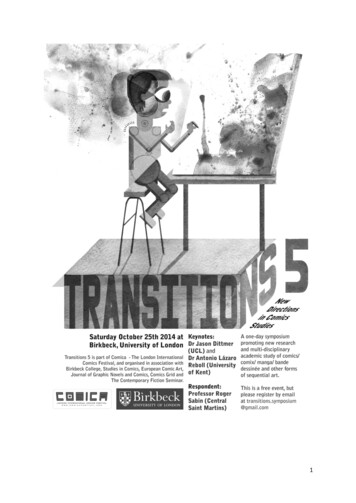
Transcription
SLC 394: Classics & ComicsCourse Catalog description: Covers topics of immediate or special interest to a facultymember and students.
Arizona State University Criteria Checklist forHUMANITIES, FINE ARTS AND DESIGN [HU]Rationale and ObjectivesThe humanities disciplines are concerned with questions of human existence and meaning, the nature ofthinking and knowing, with moral and aesthetic experience. The humanities develop values of all kinds bymaking the human mind more supple, critical, and expansive. They are concerned with the study of thetextual and artistic traditions of diverse cultures, including traditions in literature, philosophy, religion,ethics, history, and aesthetics. In sum, these disciplines explore the range of human thought and itsapplication to the past and present human environment. They deepen awareness of the diversity of thehuman heritage and its traditions and histories and they may also promote the application of this knowledgeto contemporary societies.The study of the arts and design, like the humanities, deepens the student’s awareness of the diversity ofhuman societies and cultures. The fine arts have as their primary purpose the creation and study of objects,installations, performances and other means of expressing or conveying aesthetic concepts and ideas.Design study concerns itself with material objects, images and spaces, their historical development, andtheir significance in society and culture. Disciplines in the fine arts and design employ modes of thoughtand communication that are often nonverbal, which means that courses in these areas tend to focus onobjects, images, and structures and/or on the practical techniques and historical development of artistic anddesign traditions. The past and present accomplishments of artists and designers help form the student’sability to perceive aesthetic qualities of art work and design.The Humanities, Fine Arts and Design are an important part of the General Studies Program, for theyprovide an opportunity for students to study intellectual and imaginative traditions and to observe and/orlearn the production of art work and design. The knowledge acquired in courses fulfilling the Humanities,Fine Arts and Design requirement may encourage students to investigate their own personal philosophies orbeliefs and to understand better their own social experience. In sum, the Humanities, Fine Arts and Designcore area enables students to broaden and deepen their consideration of the variety of human experience.Revised October 2008
Humanities and Fine Arts [HU]Page 2Proposer: Please complete the following section and attach appropriate documentation.ASU - [HU] CRITERIAHUMANITIES, FINE ARTS AND DESIGN [HU] courses must meet either 1, 2, or 3 and at least one ofthe criteria under 4 in such a way as to make the satisfaction of these criteria A CENTRAL ANDSUBSTANTIAL PORTION of the course content.IdentifyYESNODocumentationSubmitted1. Emphasize the study of values, of the development ofphilosophies, religions, ethics or belief systems, and/or aestheticexperience.2. Concerns the comprehension and interpretation/analysis ofwritten, aural, or visual texts, and/or the historical developmentof textual traditions.3. Concerns the comprehension and interpretation/analysis ofmaterial objects, images and spaces, and/or their historicaldevelopment.4. In addition, to qualify for the Humanities, Fine Arts and Designdesignation a course must meet one or more of the followingrequirements:a. Concerns the development of human thought, includingemphasis on the analysis of philosophical and/or religioussystems of thought.b. Concerns aesthetic systems and values, literary and visual arts.c. Emphasizes aesthetic experience in the visual and performingarts, including music, dance, theater, and in the applied arts,including architecture and design.d. Deepen awareness of the analysis of literature and thedevelopment of literary traditions.THE FOLLOWING ARE NOT ACCEPTABLE: Courses devoted primarily to developing a skill in the creativeor performing arts, including courses that are primarily studioclasses in the Herberger College of the Arts and in the Collegeof Design. Courses devoted primarily to developing skill in the use of alanguage – However, language courses that emphasizecultural study and the study of literature can be allowed. Courses which emphasize the acquisition of quantitative orexperimental methods. Courses devoted primarily to teaching skills.
Humanities and Fine Arts [HU]Page 3Course PrefixNumberTitleDesignationSLC394Classics and ComicsHUExplain in detail which student activities correspond to the specific designation criteria.Please use the following organizer to explain how the criteria are being met.Criteria (from checksheet)How course meets spirit(contextualize specific examplesin next column)Please provide detailedevidence of how course meetscriteria (i.e., where in syllabus)2. Concerns the comprehension andinterpretation of written, aural, orvisual texts, and/or the historicaldevelopment of textual traditions.This course provides anintroduction and survey of a largecollection of American comicbooks and graphic novels, in orderto understand the characteristics,history, mythology, anddevelopment over time of theAmerican superhero tradition as aliterary and visual genre.4d. Deepen awareness of theanalysis of literature and thedevelopment of literary traditions.In order to foster comprehensionand deepen student awareness ofcomic books and graphic novels asliterature, selected literary andmythological traditions of theancient Greeks and Romans areused as a model, and the courseengages in a great deal ofcomparative analysis of the twotraditions.Throughout the syllabus; thereadings and lectures focus asone of the primary themes of theclass on the three iconic figuresof the American Superhero:Superman, Batman and WonderWoman. Students are required totrace the development of thesethree figures from their earliestiterations in the 1930s and 1940sthrough their most modernrevisions and retellings. Studentsare asked to prove theirfamiliarity with the histories andmythologies of these charactersin quizzes and the final exam.As a second major theme of theclass, students are required tobcome familiar with selectancient Greek and Romanliterary traditions, including thewide variety of literature focusedon Hercules and the Trojan War,as well as more focused topicssuch as the Homeric Hymns andthe mythology of the Amazons.Finally, the classical tradition ofAncient Greek and Romanstories retold in a graphic novelformat is explored through titlessuch as Frank Miller's 300 andShanower's Age of Bronze.Students are required to analyzeSuperhero stories in comparisonto ancient Greek and Romanliterary traditions through twoshort papers and a significantfinal group project.
Humanities and Fine Arts [HU]Page 44b Concerns aesthetic systems andvalues, literary and visual artsDiscussions of the literary andvisual aesthetics of the comic booktradition are a large part of theclass, with particular emphasis onthe unique combination of literatureand art that is native to the graphicnovel genre. These discussionsoften focus on the comparativemythologies of modern graphicnovels and that of the classicalGreeks and Romans, with particularemphasis on literary and visualthemes.Very fruitful discussions oftopics such as the similaritiesbetween Hercules and Supermanare accompanied by powerpointpresentations that highlight theremarkably similar visualiconography between the twotraditions. Discussion of thedifferences between Odysseusand Batman are used to illustratethe somber, shaded realism inthe art of recent graphic novelpresentations of the latter. Theancient Greek tradition of theAmazons with regard to WonderWoman allow for discussion andcomparison of the portrayal ofheroic females in ancient andmodern contexts both literaryand visual. Student responsesboth in class an in more formalonline responses to discussionquestions are required. Finally,while comic books and graphicnovels are the primary focus asthe "canon" of superheromythology, some attention isalso paid in lectures to film andtelevision adaptations of thesestories, and students are allowedto use these adaptations assources for the final project.
Classics and Comics SLC/GRK 394Paul M. ArenaPSA 106 TTh 12-1:15pmOffice: LL164G Office Hours: MW 2:30-3:15pm; F 10-11am (online)outside of office hours, email me for an appointmentphone: 602-421-5077email: pmarena@asu.eduCourse Objectives:This course provides an introduction and survey of a large collection of American comicbooks. Modern comics contain an enormous and diverse range of content –- much of ourfocus in this course will be on the American “superhero” tradition. Indeed, this American“superhero” tradition has its own history and mythology that lends itself to a very directcomparison to the cultural and mythological traditions of Greece and Rome. So inaddition to the comics, we shall also be looking closely at the texts of Classical authors tocompare the two traditions. Finally, we shall also look at several comics that are directmodern retellings of Classical subjects. All of this will provide a very rich experience,exploring the connections between Classics and Comics.Expected Learning Outcomes:Upon successful completion of this course, students will be able to: Know the basic facts about the history of American Superhero Comics, and the generalevolution of the genre; how these comic have changed with American culture, and howClassical themes have been a large part of this development. Comprehend and interpret comics as literature, placing them within the framework oftheir cultural history, as well as other traditions. Learn to appreciate how Greco-Roman history and myths are retold in popular culture,and how this reception is an essential part of the Classical Tradition. Think critically about the reception of comics, how they affect their audience, takinginto account factors ranging from, artistic techniques, production and the intendedaudience.Grading:Graded material for the semester shall include: two short papers (Oct 4, Nov 15; 10%each), 3 quizzes (20%), a group presentation (20% each) and the final exam (FinalsWeek; 25%). For my expectations regarding papers and the exam, I shall provide anexplanation along with essay topics in separate documents available on BB. In addition,students are required to post “responses” to the weekly reading assignments. Most weeksI shall provide a few study questions for our frequent close readings of assigned comicsand texts. You will respond to these on BB via the “response” forum (More on thisbelow.) Your participation in these discussions will reflect greatly upon yourresponse/attendance/participation grade (15% of final grade.)If you have any questions about class or wider academic interests please do not hesitateto email or come and see me in my office hours or at some arranged time.
Attendance PolicyAttendance is expected. Quizzes cannot be made-up unless there is a documentedemergency.Book List (Available at the Student Book Center):Scott McCloud, Understanding Comics, and Reinventing Comics; Trzaskoma, Anthologyof Classical MythGraphic Novel List (Available at Pop Culture Paradise):Frank Miller Batman Year OneGrant Morrison All-Star Superman Vols. 1&2George Perez Wonder Woman Vol. 1 “Gods and Mortals”Brad Meltzer Justice League of America “Tornado’s Path”Geoff Johns Justice League Vol.1 (New 52) “Origin”Mark Waid Kingdom Come*Greg Pak, Incredible Hercules Vol. 3 “Love and War”Geoff Johns Batman Earth OneFrank Miller 300Eric Shanower Age of Bronze Vols. 1 & 2Alan Moore Watchmen*NOT available at Pop Culture. There will be extra copies for reading in HaydenReserven.b. The above list refers to the titles of the books and graphic novels I ordered for theclass. The Student Book Center is located at 704 South College Avenue. Pop CuluteParadise is located very close by at 715 South Forest Avenue. Pop Culture Paradise willbe offering the above graphic novels at a significant discount. HOWEVER, you willhave access to ALL the graphic novels in this course at Hayden Library Reserve:http://lib.asu.edu/access/reserves Also, digital options for comics will also be discussedfor those of you who are so inclined.Groups: I shall divide the students of the course up into 6 groups (or “teams”) of 3-4students. The classmates in your group will be your reading response partners, and moreimportantly, will form your team for a critical presentation for the semester. The detailson “teams” (and the choices you have for names!) will be posted on BB.
Responses: on BB under “Questions and Responses,” I will post a couple of questionsbefore each class. A member(s) of one of the groups will be responsible for a “readerresponse” to the questions posted. The response must be a minimum of 150 words. Yourresponses will be graded as (S)atisfactory, (U)nsatisfactory, or (E)xcellent. In addition,these responses will serve as a springboard for the class discussion the following day -–thus it will be important to get the response posted by the evening before class.Group presentation: in addition to the weekly “responses,” your groups will also beresponsible for one “comics presentation” during the semester. I will start to schedulethese 2 or 3 weeks into the course. Any comic author and character is eligible, EXCEPTfor the characters widely covered in this course. The exact parameters of the groupproject will be posted on BB in a separate document.Caveat LectorIt is very important that students remember that the purpose of this course is to studyliterature and culture. Greece and Rome are the forefathers of Western culture and manyaspects of Greek and Roman society may seem familiar to us today; however, manyaspects of their culture are also alien and might even be considered offensive in today’ssociety. In addition, while many of the American Superhero Comics we shall study willbe at most “PG” level material, some comics may feature more graphic violence andnudity than you are accustomed to. If you find some of the course content offensive,please feel free to discuss it with me, my colleagues in Classics, or the director of SILC.All of us may be contacted in person or by email.Scholastic dishonestyScholastic dishonesty on any assignment will result in a failing grade (E) for thatassignment which may not be dropped. Scholastic dishonesty includes any kind ofcheating. For the university policy, which this class follows, t.html.AccomodationsIf you require accommodations on assignments for a disability, university-sanctionedevent, or religious holiday, you must let me know in advance. See the links below for theaccommodations the university provides and that this class follows:Religious acd304-04.htmlUniversity-sanctioned 04-02.htmlDisability resources: http://www.asu.edu/aad/manuals/ssm/index.html#700. NB:Students requesting accommodation for reasons of a disability must be registeredwith the Disability Resource Center and submit the appropriate documentationfrom the DRC.Policy on behavior in the classroomDuring lectures and discussion sessions, I assume that you will listen and respond both tome and to one another. In order to accomplish this, you must refrain from usingcomputers, cellphones, PDAs, music players, etc. etc., etc. Use of these items—however
unobtrusive you may think you’re being—will result in the loss of participation points.Recording devices may be permitted at the discretion of the instructor (see me).Disruptive behavior of any sort by anyone will not be tolerated. See the universitypolicy: Schedule of Readings and AssignmentsWeek 1: Introduction; Aug 23: Syllabus; “Intro to Comics and Classics”Week 2: Aug 28: “Comics as Literature” Aug 30: Mccloud Understanding ComicsWeek 3: Sep 4: “Classical Culture”; “Hercules Papyrus” Sep 6: “Batman”Week 4: Sep 11: Miller Batman Year One Sep 13: “Superman”Week 5: Sep 18: Morrison All-Star Superman Sep 20: All-Star Superman; HomericHymns QUIZ #1Week 6: Sep 25: Hesiod Theogony Sep 27: “Wonder Woman”Week 7: Oct 2: Perez Gods and Mortals Oct 4: “Wonder Woman” (Film) PAPER #1Week 8: Oct 9: “Wonder Woman and the Amazons” Oct 11: AoCM, Hyg 1-8, Hell 157;Pin Olympian 1Week 9: Oct 16: FALL BREAK Oct18: Johns Batman Earth OneWeek 10: Oct 23: Meltzer Justice League Tornado’s Path Oct 25: Johns Justice LeagueOrigin STUDENT PRESENTATIONS BEGINWeek 11: Oct 30: McCloud Reinventing Comics QUIZ #2 Nov 1: Pak IncredibleHercules Love and WarWeek 12: Nov 6: Waid Kingdom Come Nov 8: “Retelling Antiquity in Comics”;McGinley “Hannibal goes to Rome”Week 13: Nov 13: Miller 300 Nov 15: Miller 300; Shanower Age of Bronze PAPER #2Week 14: Nov 20: Shanower Age of Bronze Nov 22: THANKSGIVING BREAKWeek 15: Shanower Age of Bronze; QUIZ #3 Nov 29: Somber, Shaded Realism: TheModern Superhero; Moore Watchmen
Week 16: Moore Watchmen Dec 6: Moore WatchmenWeek 17: Dec 11: Final Thoughts
books. Modern comics contain an enormous and diverse range of content –- much of our focus in this course will be on the American “superhero” tradition. Indeed, this American “superhero” tradition has its own history and mythology that lends itself to a very direct comparison to the


